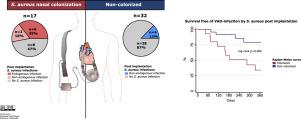当前位置:
X-MOL 学术
›
J. Infect.
›
论文详情
Our official English website, www.x-mol.net, welcomes your
feedback! (Note: you will need to create a separate account there.)
Nasal colonization with Staphylococcus aureus is a risk factor for ventricular assist device infection in the first year after implantation: A prospective, single-centre, cohort study.
Journal of Infection ( IF 14.3 ) Pub Date : 2020-02-26 , DOI: 10.1016/j.jinf.2020.02.015 Dennis Nurjadi 1 , Katharina Last 1 , Sabrina Klein 1 , Sébastien Boutin 1 , Bastian Schmack 2 , Florian Mueller 2 , Klaus Heeg 1 , Arjang Ruhparwar 3 , Alexandra Heininger 4 , Philipp Zanger 5
Journal of Infection ( IF 14.3 ) Pub Date : 2020-02-26 , DOI: 10.1016/j.jinf.2020.02.015 Dennis Nurjadi 1 , Katharina Last 1 , Sabrina Klein 1 , Sébastien Boutin 1 , Bastian Schmack 2 , Florian Mueller 2 , Klaus Heeg 1 , Arjang Ruhparwar 3 , Alexandra Heininger 4 , Philipp Zanger 5
Affiliation

|
OBJECTIVES
To assess, whether S. aureus nasal colonization is a risk factor for infections in patients with durable ventricular assist device (VAD).
METHODS
Prospective, single-centre, cohort study (i) ascertaining S. aureus nasal colonization status of patients admitted for VAD-implantation and detecting time to first episode of VAD-specific or -related infection according to International Society for Heart and Lung Transplantation criteria during follow-up and (ii) comparing whole genomes of S. aureus from baseline colonization and later infection.
RESULTS
Among 49 patients (17 colonized, 32 non-colonized), S. aureus VAD-infections occurred with long latency after implantation (inter quartile range 76-217 days), but occurred earlier (log-rank test P = 0.006) and were more common (9/17, 52.9% vs. 4/32, 12.5%, P = 0.005; incidence rates 2.81 vs. 0.61/1000 patient days; incidence rate ratio 4.65, 95% confidence interval 1.30-20.65, P = 0.009) among those nasally colonized with S. aureus before implantation. We found a similar but less pronounced effect of colonization status when analysing its effect on all types of VAD-infections (10/17, 58.8% vs. 7/32, 21.9%, P = 0.01). These findings remained robust when adjusting for potential confounders and restricting the analysis to 'proven infections'. 75% (6/8) of paired S. aureus samples from colonization and VAD-infection showed concordant whole genomes.
CONCLUSIONS
In patients with durable VAD, S. aureus nasal colonization is a source of endogenous infection, often occurring months after device-implantation and affecting mostly the driveline. Hygiene measures interrupting the endogenous route of transmission in VAD-patients colonized with S. aureus long-term may about half the burden of infections and require clinical scrutiny.
中文翻译:

金黄色葡萄球菌鼻腔定植是植入后第一年发生心室辅助装置感染的危险因素:一项前瞻性,单中心,队列研究。
目的评估金黄色葡萄球菌鼻腔定植是否是持久性心室辅助装置(VAD)患者感染的危险因素。方法进行前瞻性,单中心,队列研究(i)确定接受VAD植入的患者的金黄色葡萄球菌鼻定植情况,并根据国际心脏和肺移植协会的标准检测到第一次VAD特异性或相关感染的时间在随访过程中,以及(ii)比较基线定居和以后感染后金黄色葡萄球菌的整个基因组。结果在49例患者中(17例定植,32例未定殖),金黄色葡萄球菌VAD感染在植入后潜伏期较长(四分位间距为76-217天),但发生时间较长(对数秩检验P = 0.006),并且更常见(9/17,52.9%vs.4 / 32,12.5%,P = 0.005;发生率2.81 vs. 0.61 / 1000病人的天数;植入前经鼻金黄色葡萄球菌定植者的发病率比率为4.65,95%置信区间为1.30-20.65,P = 0.009)。分析定植状态对所有类型的VAD感染的影响时,我们发现了定植状态具有类似但不太明显的影响(10 / 17,58.8%,而7 / 32,21.9%,P = 0.01)。当针对潜在的混杂因素进行调整并将分析限制为“已证实的感染”时,这些发现仍然很可靠。来自定植和VAD感染的成对金黄色葡萄球菌样品的75%(6/8)显示了一致的整个基因组。结论在具有持续性VAD的患者中,金黄色葡萄球菌的鼻部定植是内源性感染的来源,通常发生在装置植入后数月,并且主要影响动力传动系统。
更新日期:2020-02-26
中文翻译:

金黄色葡萄球菌鼻腔定植是植入后第一年发生心室辅助装置感染的危险因素:一项前瞻性,单中心,队列研究。
目的评估金黄色葡萄球菌鼻腔定植是否是持久性心室辅助装置(VAD)患者感染的危险因素。方法进行前瞻性,单中心,队列研究(i)确定接受VAD植入的患者的金黄色葡萄球菌鼻定植情况,并根据国际心脏和肺移植协会的标准检测到第一次VAD特异性或相关感染的时间在随访过程中,以及(ii)比较基线定居和以后感染后金黄色葡萄球菌的整个基因组。结果在49例患者中(17例定植,32例未定殖),金黄色葡萄球菌VAD感染在植入后潜伏期较长(四分位间距为76-217天),但发生时间较长(对数秩检验P = 0.006),并且更常见(9/17,52.9%vs.4 / 32,12.5%,P = 0.005;发生率2.81 vs. 0.61 / 1000病人的天数;植入前经鼻金黄色葡萄球菌定植者的发病率比率为4.65,95%置信区间为1.30-20.65,P = 0.009)。分析定植状态对所有类型的VAD感染的影响时,我们发现了定植状态具有类似但不太明显的影响(10 / 17,58.8%,而7 / 32,21.9%,P = 0.01)。当针对潜在的混杂因素进行调整并将分析限制为“已证实的感染”时,这些发现仍然很可靠。来自定植和VAD感染的成对金黄色葡萄球菌样品的75%(6/8)显示了一致的整个基因组。结论在具有持续性VAD的患者中,金黄色葡萄球菌的鼻部定植是内源性感染的来源,通常发生在装置植入后数月,并且主要影响动力传动系统。









































 京公网安备 11010802027423号
京公网安备 11010802027423号